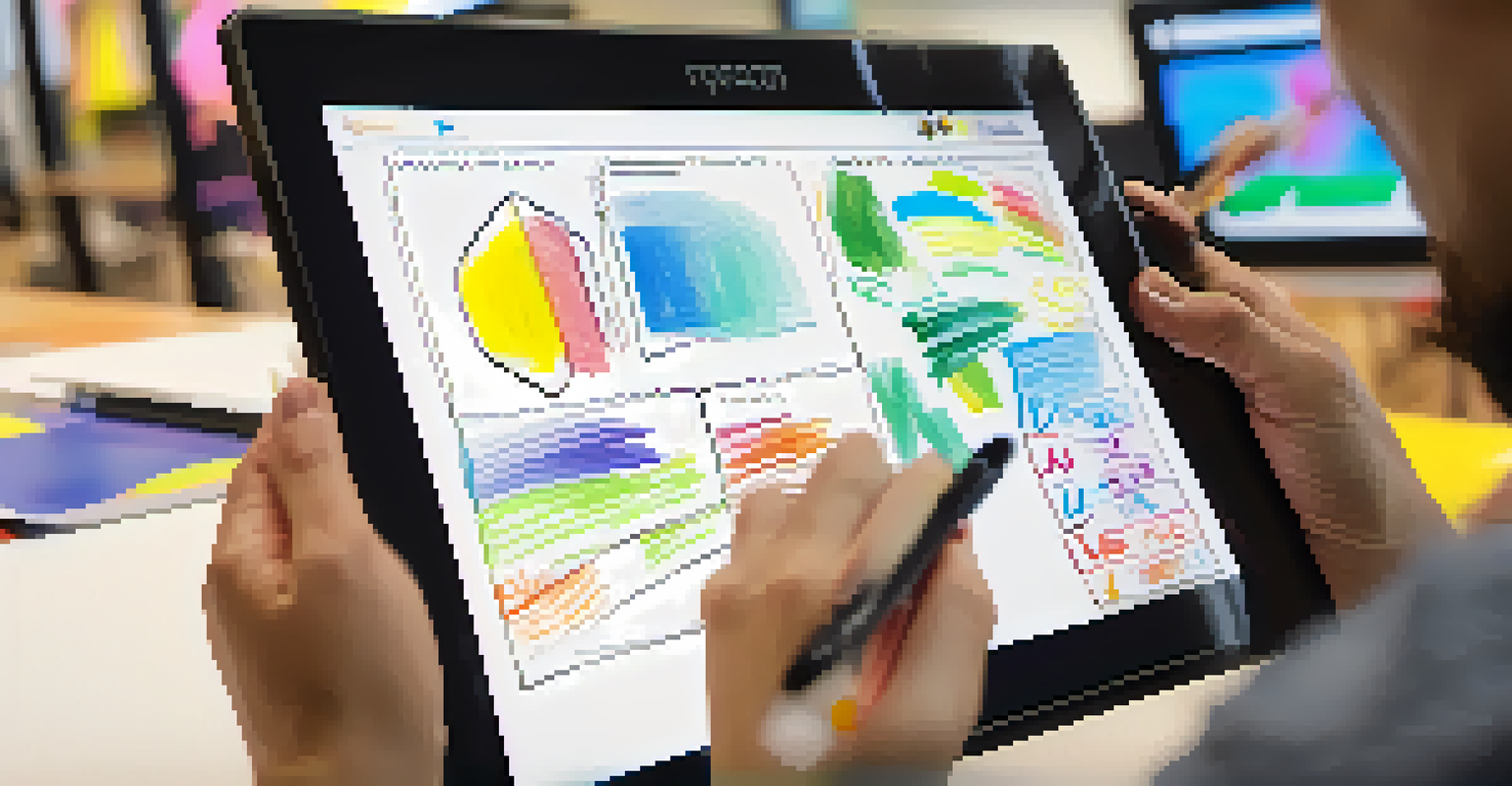The Role of Digital Tools in Collaborative Learning

Understanding Collaborative Learning in the Digital Age
Collaborative learning is a teaching strategy that involves groups of students working together to solve problems or complete tasks. In this digital age, it has evolved significantly, integrating technology to enhance interaction and engagement. With students often spread across different locations, digital tools have become essential for effective collaboration.
Alone we can do so little; together we can do so much.
The essence of collaborative learning lies in its ability to foster communication, critical thinking, and teamwork. These skills are crucial not only in educational settings but also in the workplace. By leveraging digital platforms, students can share ideas and resources seamlessly, making the learning process more dynamic and inclusive.
Moreover, the use of digital tools allows for diverse learning styles and paces, accommodating individual needs while still promoting group work. This flexibility enriches the learning experience as students can contribute in ways that suit their strengths, leading to a deeper understanding of the subject matter.
Key Digital Tools Enhancing Collaborative Learning
There are numerous digital tools available that significantly enhance collaborative learning. Platforms like Google Workspace, Microsoft Teams, and Slack provide spaces for real-time communication and document sharing, making group projects more manageable. These tools allow students to brainstorm ideas, assign tasks, and track progress in one central location.

In addition, virtual whiteboards such as Miro and Jamboard offer interactive ways for students to visualize concepts and collaborate on projects. These platforms enable brainstorming sessions where ideas can be easily shared and arranged, fostering creativity and collective problem-solving. The visual aspect can help to clarify complex topics and engage all participants.
Digital Tools Enhance Collaboration
Integrating digital tools in education fosters communication, critical thinking, and teamwork among students.
Finally, video conferencing tools like Zoom and Microsoft Teams bridge the gap for remote learners by facilitating face-to-face interactions. This is crucial for building relationships and maintaining a sense of community, even when physical presence isn't possible. Such interactions can mimic in-person group discussions, enhancing the collaborative experience.
Benefits of Digital Tools in Collaborative Learning
One of the primary benefits of digital tools in collaborative learning is the increased accessibility they offer. Students can access materials and collaborate anytime and anywhere, breaking down geographical barriers. This ensures that everyone, regardless of their location, can contribute equally to group projects.
Collaboration allows us to know more than we are capable of knowing by ourselves.
Additionally, these tools often come with features that promote organization and accountability. For instance, task management applications like Trello or Asana allow teams to assign responsibilities and set deadlines, ensuring that all members are engaged and on track. This structured approach can help prevent misunderstandings and keep the project progressing smoothly.
Moreover, digital tools facilitate a more inclusive environment, allowing quieter students to participate more comfortably. By providing various modes of interaction, such as chat functions or comment sections, all voices can be heard, making collaboration richer and more diverse.
Challenges of Using Digital Tools for Collaboration
While digital tools offer many advantages, they also come with challenges that educators and students must navigate. One major issue is the potential for technological glitches or internet connectivity problems, which can disrupt group work. It's essential for students and educators to have backup plans to maintain momentum even when issues arise.
Another challenge is the learning curve associated with new tools. Not all students may be familiar with the platforms being used, which can lead to frustration or disengagement. Providing training sessions or resources can help mitigate this issue, ensuring that all participants feel comfortable and capable of using the technology effectively.
Accessibility and Inclusivity Matter
Digital tools break down geographical barriers, ensuring equal participation and accommodating diverse learning styles.
Lastly, there can be a tendency for some students to dominate discussions or tasks when working digitally. Without the physical cues present in in-person interactions, it's easy for more vocal individuals to overshadow their peers. Encouraging equitable participation through structured roles or guidelines can help balance contributions and enrich the collaborative experience.
Integrating Digital Tools into Curriculum Design
For educators looking to enhance collaborative learning, integrating digital tools into curriculum design is essential. This involves thoughtfully selecting tools that align with the learning objectives and the needs of the students. By embedding these tools into the curriculum from the beginning, students can develop their digital literacy alongside their collaborative skills.
It's also important to consider the types of activities that will best leverage these tools. Group projects, peer reviews, and discussions can all benefit from the right digital platforms, fostering an environment where students learn from each other. Educators should be creative in how they incorporate technology to enhance engagement and participation.
Moreover, regular reflection on the effectiveness of these tools in achieving learning outcomes is crucial. Gathering feedback from students can provide insights into what works and what doesn't, allowing educators to adjust their approach and continually improve the collaborative learning experience.
Future Trends in Digital Collaborative Learning
As technology continues to evolve, so too will the tools available for collaborative learning. Emerging technologies like artificial intelligence (AI) and virtual reality (VR) are beginning to play a role in education, offering innovative ways for students to collaborate and interact. For instance, VR can create immersive learning environments where students can work together in a virtual space, regardless of their physical location.
Additionally, the rise of gamification in education is changing how collaborative learning is approached. By incorporating game-like elements into group projects, educators can motivate students to engage more deeply and work together effectively. This trend not only makes learning fun but also encourages teamwork and problem-solving.
Challenges Require Proactive Solutions
Addressing potential issues like tech glitches and uneven participation is essential for successful collaborative learning.
Finally, increased emphasis on data analytics in education may lead to more personalized collaborative experiences. By analyzing student performance and engagement levels, educators can tailor group activities to better suit their needs, ensuring that every student can contribute meaningfully. This adaptability will be essential for fostering a collaborative culture in the classroom of the future.
Conclusion: Embracing Digital Tools for Better Learning Outcomes
In conclusion, digital tools play a transformative role in collaborative learning, offering numerous benefits that enhance educational experiences. They not only facilitate communication and organization but also promote inclusivity and accessibility for all students. As such, embracing these tools can lead to improved learning outcomes and a more engaging classroom environment.
However, it's crucial to remain mindful of the challenges that come with technology integration. By addressing these issues proactively and incorporating digital tools thoughtfully into the curriculum, educators can create a supportive environment that maximizes collaboration. Continuous adaptation and feedback will be key to success.

Ultimately, the goal is to prepare students for a world where teamwork and technology go hand in hand. By equipping them with the skills to collaborate effectively using digital tools, we are not only enhancing their learning experience but also preparing them for future challenges in both their professional and personal lives.